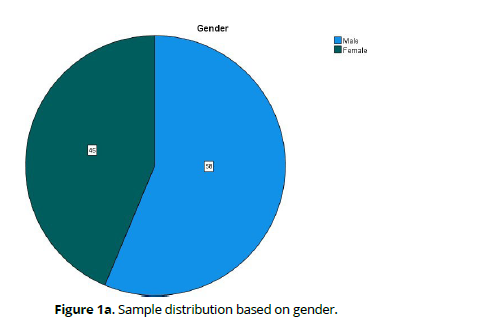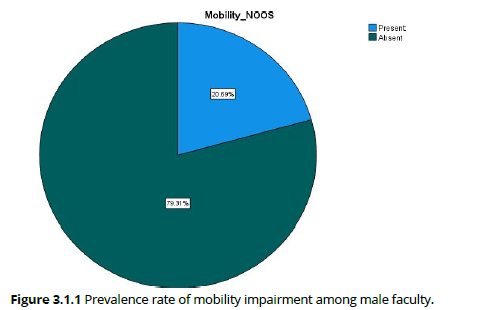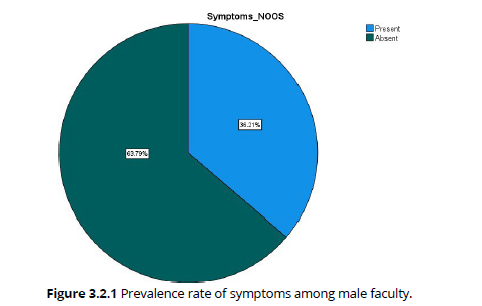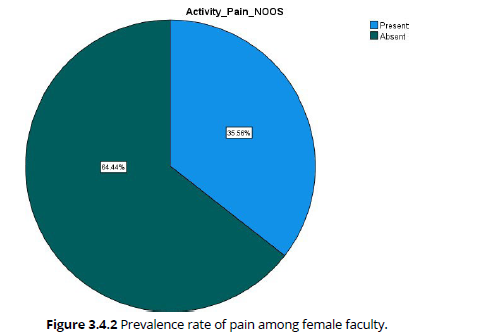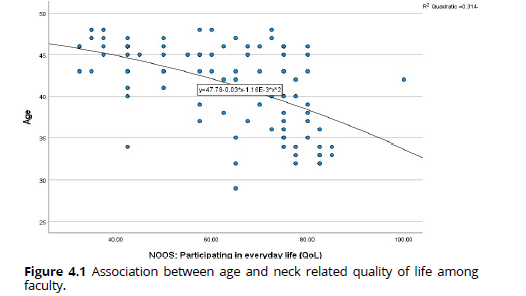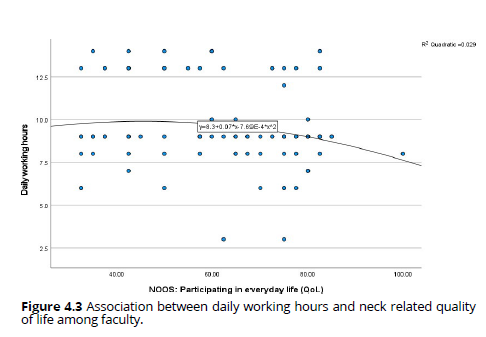Review Article - (2023) Volume 18, Issue 6
Neck Related Problems And Quality Of Life Among Technology Users Of Faculty Members At Majmaah University Saudi Arabia
Faisal Ghanem Alanazi* and Abdulaziz Mohammed Altuwaijri*Correspondence: Faisal Ghanem Alanazi, College of Applied Medical Science, Majjmah University, Saudi Arabia, Email:
Received: 02-Dec-2023 Accepted: 18-Dec-2023
Abstract
Background: About 34.4% of office employees worldwide experience neck pain related to musculoskeletal disorders each year. The primary objective of this study was to assess the prevalence of neck related problems among technology users of faculty members of Majmaah University, Saudi Arabia. The secondary objective of this study was to assess the relationship between demographic characteristics, technology usage and quality of life among faculty members of Majmaah University, Saudi Arabia.
Methods: A Cross-sectional study was conducted at various colleges of Majmaah University of both male and females aged between 30 to 55 years with a minimum of one year of experience/exposure to technology usage were included in the study. Study participants with chronic systemic ailment, recent fractures, on medication, receiving physiotherapy, or undergone recent surgery were excluded. A sample size of 369 faculty invited for the study, a convenience sampling method was adopted. The Neck Outcome Score (NOOS) English version was circulated among the sample after written informed consent. Demographic parameters do not follow normal distribution. Hence, expressed in median, geometric mean with 95% confidence interval (CI); number with percentage. Prevalence of neck related symptoms were estimated in frequency and percentages. Spearman rank correlation was used to report the association between these parameters & Quality of life (NOOS_QOL).
Results: The median age of the faculty 41.7, 40.9 years. Prevalence of neck related symptoms such as mobility impairment, symptoms, sleep disturbance and pain in males were 20.7%, 36.2%, 5.2%, 37.9%; in females 24.4%, 26.7%, 13.3%, 35.6% respectively. Age has significant -0.577 (p<0.001) moderate to good degree of negative association with NOOS-QoL among the faculty. Similarly, daily keyboard use has significant -0.205 (p=0.038) little degree of negative association with NOOS-QoL. While in other parameters with NOOS-QoL, there exist no significant associations between them.
Conclusion: Neck related symptoms were prevalent among technology users of male and female faculty, as age and daily time spent using keyboard increased, neck related Quality of life decreased among technology users of male and female faculty at Majmaah University, Saudi Arabia
Keywords
Prevalence. Neck symptoms. Technological gadgets. Quality of life. Saudi arabia
Introduction
Neck pain, also known as cervicalgia, is pain around the spine below the head. The neck is also sometimes called cervical spine. Neck pain is a type of pain that originates in the neck and may radiate down one or both arms. Many conditions or illnesses that affect the neck's tissues, nerves, bones, joints, ligaments, or muscles can cause neck pain. 16.7 to 75.1% of people worldwide experience chronic neck pain each year [1]. One of the most common musculoskeletal disorders is neck pain, having a prevalence rate of 27.0 per 1000 population in 2019 [2]. In 2012, neck pain was responsible for job absences among 25.5 million Americans, who missed an average of 11.4 days of work [3]. Compared to those who don't have neck pain, people with neck discomfort are more likely to have poorer quality sleep. The fourth leading cause of disability is neck pain, with an annual prevalence rate of more than 30%. Most acute neck pain episodes will resolve by themselves with or without treatment, but nearly 50% of people who have neck pain will continue to fell some degree of pain or frequent occurrences [4]. Ankylosing spondylitis, rheumatoid arthritis, polymyalgia rheumatica, tumors, and infections are among the disorders that account for 10% of neck pain [5]. It was discovered that neck discomfort and impairment can influence how physically demanding a person's current employment is while also impairing their capacity to sleep [6, 7]. Office workers frequently get neck disorders due to their jobs, particularly computer users. [8, 9] Due to a growth in computer-based tasks at work and during leisure activities, people now utilize technology devices more than they did in the past and for longer periods of time [9].
A 2017 study conducted in Saudi Arabia discovered a correlation between gender and the type of device used for amusement and for learning [10]. Several studies have been conducted how the neck pain effect the person ability to perform the job duty, however this study has two objectives, the primary objective of this study is to assess the prevalence of neck related problems among technology users of faculty members of Majmaah University, Saudi Arabia, the secondary objective is to assess the relationship between demographic characteristics, technology users and quality of life among faculty members of Majmaah University, Saudi Arabia.
Aim of the study
The current research aimed to estimate the prevalence of neck related problems and assess the association between demographic characteristics, technology users and quality of life among faculty members of Majmaah University, Saudi Arabia.
Objectives of the study
The primary objective of this study is to assess the prevalence of neck related problems among technology users of faculty members of Majmaah University, Saudi Arabia, the secondary objective is to assess the relationship between demographic characteristics, technology users and quality of life among faculty members of Majmaah University, Saudi Arabia.
Operational definition
Modern technological gadgets influence the health status of the neck and their association with quality of life.
Hypothesis
Frequent use of technological gadgets has an influence on the health status of the neck and their association with quality of life.
Frequent use of technological gadgets has a no influence on the health status of the neck and their association with quality of life.
Review of literature
Work-related musculoskeletal disorders are defined as repetitive traumarelated injuries to the musculoskeletal system, including the nerves, tendons, muscles, bone, joints, ligaments, spinal disc, and cartilage and are frequently accompanied by pain, stiffness, redness, edema, and weakness (12). Safri et al, (2020) have estimated the Global prevalence of neck pain among general population of 195 countries and stated that years lived with disability, and age standardized point prevalence of neck pain did not vary between 1990 and 2017, its burden remained significant (13).
Kazeminasab et al. (2022) have described in their literature review that the age and sex, as well as long-term stress, can have an impact on the prevalence and progression of neck pain (14). Jahre H et al. (2020) have conducted a systematic review on risk factors of neck pain and concluded that the work and study time, workload, posture during work, lack of physical activity and computer usage were the most important risk factors in neck pain. (15)
Hoy et al. (2010) in their epidemiology of neck pain study have stated that the overall prevalence of neck pain in the general population ranges between 0.4 and 86 percent. According to available studies, the incidence of neck pain over a 12-month period ranges from 10.4 to 21.3 percent, with office and computer workers having a higher incidence (16). Sherif et al. (2018) have done a prevalence study on musculoskeletal disorders among 60 faculty members at the college level with an objective to determine the prevalence and factors associated with work-related musculoskeletal disorders (WMSDs) and found that the neck complaint was the most prevalent (53.5%) among computer users (17).
Anas et al. (2022) in their study with an aim to assess the prevalence and risk factors of neck pain among office workers at the Ministry of Health in Saudi Arabia and have found that many of the office workers experienced neck pain and it was disproportionately prevalent in men who work long hours (12). James et al. (2018) have performed a systematic analysis for the Global Burden of Disease Study on Global, regional, and national incidence, prevalence, and years lived with disability for 354 diseases and injuries for 195 countries and territories from 1990–2017 and have found that the neck pain has been a growing problem and lowering people's quality of life (11). Hey et al. (2021) have conducted an epidemiological study with an aim to describe the prevalence, risk factors, disability, and quality of life (QoL) burden of neck pain among 144 participants aged 21 and older in public households in Singapore and their findings have shown that the neck pain was a prevalent condition with chronicity and severity of symptoms associated with reduced quality of life (QoL) (18). Algarni et al. (2022) have conducted a cross-sectional study on Quality of life in working population with and without musculoskeletal pain in Saudi Arabia with a sample of 2042 workers. They have used a generic SF- 36 questionnaire to evaluate the quality-of-life construct and most of them experienced musculoskeletal pain during the past 12 months (one year prevalence) and found that the neck and back pain were the most frequently reported areas of discomfort in these employees [19]. In Taif, Saudi Arabia a study done to determining the association between non-specific neck pain and the use of smart phones, iPads, laptops, and computers by university students. They found out that approximately 64% of the students never complained of neck pain, while 8.2% suffered from neck pain either often or very often (21).
A study done in Iran name of that is Work-related Musculoskeletal Disorders in Iranian Office Workers: Prevalence and Risk Factors was aimed to identify the prevalence of musculoskeletal disorders (MSDs) and ergonomic risks for Kerman University of Medical Sciences’ office workers. The results showed that the highest prevalence rates of MSDs were in the lower back (72.4%) and neck (55.2%) (22).
Juul et al. (2015) have developed a disease specific Neck OutcOme Score (NOOS) questionnaire which assesses the neck related problems/constructs such as mobility, stiffness, symptoms, sleep disturbance, everyday activity, and pain, participating in everyday life and quality of life related to neck problems. Since it is a disease specific questionnaire, it measures the quality of life due to specific characteristics of neck related problems (20).
Methodology
Research design
A Cross-sectional study
Population
University faculty members both male and females aged between 30 to 55 years with a minimum of one year of experience/exposure to technology usage.
Sample and sampling method
A sample of 370 University faculty members and convenience sampling method was adopted.
Selection criteria
The University faculty members both male and females aged between 30 to 55 years with a minimum of one year of experience/exposure to technology usage were included in the study.
Study setting
Study was conducted at various colleges of Majmaah University, Saudi Arabia. Variables of the study
Dependent variables: Neck symptoms
Independent variables: NOOS questionnaire
Instruments used
NOOS English questionnaire and personal information questionnaire.
Procedure
The University faculty members working at various colleges of Majmaah University participated in the study. All participants were provided the informed
consent. The faculty members who have been using modern technology gadgets for at least one year have taken an initial interview along with personal characteristics of the participants and included information on age, body mass index, and education. The information on workplace factors including current work history, previous experience, long work hours, average working hours with computers (desktop and laptop, etc.), average working time with each gadget taken and A self-administered questionnaire Neck Outcome Score (NOOS) English version was used to estimate the prevalence of neck related problems. A total of 369 copies of the questionnaire were distributed among potential participants who were chosen by convenience sampling technique. Among 369 target participants, 103 study participant responses received, and the response rate was 28% (103/369), had neck related symptoms as per the scoring system of NOOS questionnaire. All participants were explained about the questionnaire individually. The Neck Outcome Score (NOOS) English version was created as a tool for determining how patients perceive their neck-related issues. As per the international Classification of Functioning (ICF) established by WHO, it is a quantified measurement of the patient's neck disability. NOOS
English version is self-administered and user friendly, and it takes about 10- 15 minutes to fill out. The NOOS English version consists of 34 items broken down into five subscales: Mobility (with seven questions), Symptoms (with five questions), Sleep disturbance (with four questions), Everyday activity and pain (with eight questions), and Participation in Everyday Life (with four questions including quality of life). When responding to the questions, the preceding week was taken into consideration.
There are five Likert boxes for standard responses, and each question receives a score of 0 to 4. Each subscale receives a normalized score, with 100 representing no symptoms and 0 representing severe symptoms. As an outcome profile, the result can be plotted. Focus group interviews with 24 neck pain patients and 12 health care professionals ensured the NOOS' English version content validity (13). In 196 neck pain patients, the psychometric properties of reliability, validity, interpretability, and responsiveness of NOOS English version questionnaire were examined (14).
Statistical analysis
The collected data was analyzed by using the statistical software, Statistical
Package for the Social Sciences – Version 27.0 (SPSS 27.0) software for Windows. The collected data's normality was measured using the Kolmogorov-Smirnov test. Data did not follow normal distribution, so descriptive statics were expressed in median with interquartile range and range or geometric mean (95% confidence interval). The prevalence rate of neck related problems among technology users of faculty members of Majmaah University, Saudi Arabia was expressed as a whole number with percentage. The correlation between neck related problems and quality of life was measured using the Spearman Rank correlation coefficient test as did not follow normal distribution. For all the above statistical analyses, the significance level will be set at less than 5% to minimize type 1 error.
Ethical issues (if applicable)
There were no Ethical issues. Ethical approval was obtained from the Majmaah University for Research Ethics Committee. Informed written consent will be obtained from all selected participants. Confidentiality and privacy will be assured for their data.
Results
Table 1 displays the information pertaining to the demographic features of the subjects. This study had a greater representation of male faculty members than female 58(65.31%), 45 (43.69%); the median with interquartile range age of the male and female sample were 41.7 (40.8 to 43.2), 40.9 (39.6 to 42.9) respectively.
| Demographic Parameters | Geometric means( 95% CI) ; (N) % | |
|---|---|---|
| Male | Female | |
| Gender | 58(65.31%) | 45 (43.69%) |
| Age | 41.7 (40.8 to 43.2) | 40.9 (39.6 to 42.9 |
Information about the workplace characteristics of the participants with neck pain is given in Table 2. The median work experience at Majmaah University males & females were 9.2 (9.1 to 10.5), 7.6 (7.7 to 10.1) years. Male & female participants reported working hours 9.1 & 8.3 hours per day. All the male & female participants had various hours of technology usage such as daily mobile use (both 5.2hours), daily tablet use (0.5, 0.4hours), daily keyboard use (4.2, 3.6 hours), daily laptop use (both 3.2hours), external mouse use (1.7, 1.9hours).
Characteristics |
Male (n=58) | Female (n=45) |
|---|---|---|
| Age | 41.7 (40.8 to 43.2) | 40.9 (39.6 to 42.9) |
| Current experience (years) | 9.2 (9.1 to 10.5) | 7.6 (7.7 to 10.1) |
| Daily working hours | 9.1 (8.7 to 10.3) | 8.3 (8.9 to 10.1) |
| Daily mobile use (hours) | 5.2 (5.1 to 5.5) | 5.2 (4.9 to 5.5) |
| Daily tablet use (hours) | 0.5 (0.4 to 0.7) | 0.4 (0.3 to 0.7) |
| Daily keyboard use (hours) | 4.2 (4.1 to 5.1) | 3.6 (3.1 to 4.1) |
| Daily laptop use (hours) | 3.2 (2.9 to 3.8) | 3.2 (1.9 to 2.3) |
| External mouse use (hours) | 1.7 (1.8 to 2.3) | 1.9 (1.7 to 2.2) |
Table 3 show that there is a prevalence of neck symptoms/related problems among male & female faculty members. According to the participants' neck symptoms/related problems pattern, neck pain had the higher prevalence in males (37.9%) than females (35.6%) then followed by symptoms such as headache, dizziness had the higher prevalence in males (36.2%) than females (26.7%); then mobility impairment had the higher prevalence in females (24.4%) than males (20.7%); then sleep disturbances had the higher prevalence in females (13.3%) than males (5.2%).
Characteristics |
Neck related symptoms (NOOS) in N (%) | |||
|---|---|---|---|---|
| Gender | Mobility | Symptoms | Sleep Disturbances | Pain |
| Male | 12 (20.7) | 21 (36.2) | 3 (5.2) | 22 (37.9) |
| Female | 11(24.4) | 12 (26.7) | 6 (13.3) | 16 (35.6) |
Age has significant (p<0.001) moderate to good degree of negative association with NOOS- QoL among the faculty. Similarly, daily key board use has significant (p=0.038) little degree of negative association with NOOS-QoL. In both the above situations, as age and daily time spent using key board increases, NOOSQoL decreases. While in other demographic parameters with NOOS-QoL, there exist no significant associations between them, Table 4.
Demographic parameters & Technology usage gadgets |
Correlate with QoL [Spearman’s rho (ρ)/(rs)] | P-value |
|---|---|---|
| Age | -0.577 | <0.001 |
| Current experience (years) | -0.014 | 0.889 |
| Daily working hours | -0.121 | 0.223 |
| Daily mobile use (hours) | -0.103 | 0.303 |
| Daily tablet use (hours) | -0.108 | 0.278 |
| Daily keyboard use (hours) | -0.205 | 0.038* |
| Daily laptop use (hours) | -0.059 | 0.552 |
| External mouse use (hours) | -0.007 | 0.945 |
Discussion
The current study is the first of its kind to be carried out in Saudi Arabia with the goal of determining the prevalence of neck-related disorders and the association between demographic traits, technology users, and quality of life among faculty at Majmaah University in Saudi Arabia. Most of the studies reported the affects of modern technology gadgets on different anatomical regions of the human body and their association between demographic traits and technology users, but none reported their adverse effects on living standards on one’s own life at workstation and other walks of life; quantifying the quality of life effected with these gadgets.
The current study tried to quantify the QoL among faculty at Majmaah University which suggests future recommendations about the quality and quantity of work production estimations among faculty thereby overall University productive functionality to build the nation stronger with its vision 2030.
The generalizability of the results of the current study prevalence rates of neck problems are pertaining to Majmaah University in Saudi Arabia as the sample represented from various colleges of both male and female faculty of Majmaah University. The faculty researchers of previous study observed a one-year prevalence rate of neck problems were higher among the rest of the studied regions of the body and females reported higher prevalence of neck pain than in males (17) where as our study reported higher prevalence among males, several factors would have contributed for this discrimination as our male sample differ than females in terms of higher age, more years of work experience and higher hours of technology usage compared to females.
Moreover, the previous study reported their prevalence rates during the year 2017-2018. Hence, possibility of differences in prevalence rates as influenced by various risk factors and their dominance. Our study used a disease-specific validated neck questionnaire to accurately assess the neck symptoms than when used with a generalized/comprehensive questionnaire. The median age of the male sample faculty 41.7 years had experienced more neck symptoms and higher prevalence than their median age of the counterpart female sample faculty 40.9 years. Controlling the gender factor of the previous study (17), the age range was inline with the age of our median sample in terms of neck prevalence. Our male sample higher response rate compared to females and higher number of current working years had shown higher prevalence of neck symptoms than the previous study in these factors and within our study the same reasons hold true for the higher prevalence of neck symptoms. The previous study has concluded (17) that higher hours of keyboard usage was found to be one reason for higher prevalence of neck symptoms, whereas the same reason in our study with more years of keyboard usage showed the higher prevalence than females.
The prevalence rate recorded by our study's faculty members is different from the prevalence reported by Majmaah University, CAMS faculty, Brazilian university professors (85.7%) and female schoolteachers in the Saudi Arabian city of Al-Khobar (79.17%). The different work environments and biological variations comparative of the sample might be a contributing factor to the indiscriminate rates found in the studies (17, 23, 24).
The incidence of neck related problems observed in the current study is more or less similar with a study that found that bank employees in Kuwait had a neck prevalence rate of 53.5%. The level of computer/keyboard use in the work contexts may be one explanation for why the findings of these research studies differ, moreover the epidemiological/prevalence rates reporting any noncommunicable disease (NCDs) prevalence rates varies with varied factors such as geographical, environmental, and biological variations such as age, energy efficiency (25) which delineates comparing to emphasize the importance of the studies conducted unlike experimental studies where adopted parameters need to show the effects of interventions.
In terms of demographic parameters when correlated with neck outcomes, our sample age factor has significant (p<0.001) moderate to good degree of negative association with NOOS- Quality of Life among the faculty, demonstrating substantial decline in neck related Quality of Life as the age increased. One recent study has concluded that the age was positively correlated with neck disability (26). When compared with the previous study our results showed low correlation and were similar with the previous study (17), demonstrating that the excessive keyboard usage has negative impact on neck symptoms. One recent study has found the positive correlation between forward head posture and increased neck symptoms and long hours of keyboard usage sustain the head in forward posture and would have led to the increased neck symptoms (27). Rossignol et al. found a 4-fold rise in the likelihood of neck pain among computer operators and data processors in their study using a keyboard (28). When the forearm is not supported when typing on the keyboard, the load on the trapezius muscle is increased, which causes neck pain (29)?
Though the hypothesized statement regarding the correlation between technological gadgets/tools and neck related Quality of Life resulted low association, some possible reasons such as well-designed office workstations, infrequent use of different technological gadgets with various positions to use, frequent breaks from using keyboards due to teaching hours and other academic activities such as meeting would have led to low correlation. The above discussed risk factors such as demographic parameters such as age, modern technological gadgets/tools such as keyboard utility had led to prevalence of neck symptoms and such long standing symptoms have led to the declined neck related Quality of Life among male and female faculty (pooled gender NOOS-QoL outcomes) at Majmaah University in Saudi Arabia.
Strength and limitations
Comprehensive domains of NOOS questionnaire to evaluate neck symptoms has led the study a more valid and the results are generalizable for preventive strategies of neck related problems.
We did not separate potential computer professionals from non- computer professionals where keyboard usage substantially differs and might have affected our results. A future in dept study is recommended to consider only computer professionals involving number of hours of keyboard usage to see the cause-and-effect relations.
Conclusion
Neck related symptoms were prevalent among technology users of male and female faculty, as age and daily time spent using keyboard increased, neck related Quality of Life decreased among male and female faculty at Majmaah University, Saudi Arabia. Periodic ergonomic training and leisure activities are recommended to improve neck related Quality of Life at work thereby their work efficiency towards university improvement as a whole.
References
Hadamus A, Wojda A, Białoszewski D. Can the sleep quality of patients with chronic neck pain be improved by muscle energy techniques combined with Swedish massage? Complement Ther Clin Pract. 2021;44: 101421.
Kazeminasab S, Nejadghaderi SA, Amiri P, Pourfathi H, Araj-Khodaei M, Sullman MJM, Kolahi AA, Safiri S. Neck pain: global epidemiology, trends and risk factors. BMC Musculoskelet Disord. 2022 Jan 3;23(1):26. doi: 10.1186/s12891-021-04957-4. PMID: 34980079; PMCID: PMC8725362.
Lezin N, Watkins-Castillo S. The impact of musculoskeletal disorders on Americans- opportunities for action. Burden Musculoskelet Dis US Prev Soc Econ Cost. 2016;3.
Cohen SP. Epidemiology, diagnosis, and treatment of neck pain. Mayo Clin Proc. 2015;90(2):284–99.
American College of Rheumatology, https://rheumatology.org/
Duman M, Timur TS. The effect of sleep hygiene education and relaxation exercises on insomnia among postmenopausal women: a randomized clinical trial. Int J Nurs Pract. 2018;24: e12650.
Hallman DM, Birk Jorgensen M, Holtermann A. Objectively measured physical activity and 12-month trajectories of neck-shoulder pain in workers: a prospective study in DPHACTO. Scand J Public Health. 2017;45(3):288–98.
Jensen C. Development of neck and hand-wrist symptoms in relation to duration of computer use at work. Scand J Work Environ Health. 2003; 29:197–205.
Cagnie B, Danneels L, Van Tiggelen D, De Loose V, Cambier D. Individual and work- related risk factors for neck pain among office workers: a cross sectional study. Eur Spine J. 2007 May;16(5):679-86. doi: 10.1007/s00586-006-0269-7. Epub 2006 Dec 8. PMID: 17160393; PMCID: PMC2213555.
Almalki MM, Algarni SS, Almansouri BH, Aldowsari MA. Use of smartphones, ipads, laptops and desktops as a risk factor for non-specific neck pain among undergraduate university students. Egypt J Hosp Med. 2017; 69:2438–41.
James SL, Abate D, Abate KH, Abay SM, Abbafati C, Abbasi N, Abbastabar H, Abd- Allah, F, Abela J, Abdelalim A et al. Global, regional, and national incidence, prevalence, and years lived with disability for 354 Diseases and Injuries for 195 countries and territories, 1990–2017: A systematic analysis for the Global Burden of Disease Study 2017. Lancet 2018, 392, 1789–1858.
Hayes M, Cockrell D, Smith DR. A systematic review of musculoskeletal disorders among dental professionals. Int J Dent Hyg. 2009 Aug;7(3):159-65. doi: 10.1111/j.1601- 5037.2009.00395. x. PMID: 19659711.
Safri S, Kolahi A-A, Hoy D, Buchbinder R, Mansournia MA, Bettampadi D, et al. Global, regional, and national burden of neck pain in the general population, 1990–2017: systematic analysis of the Global Burden of Disease Study 2017. BMJ. 2020;368
Kazeminasab S, Nejadghaderi SA, Amiri P, Pourfathi H, Araj-Khodaei M, Sullman MJM, Kolahi AA, Safiri S. Neck pain: global epidemiology, trends and risk factors. BMC Musculoskelet Disord. 2022 Jan 3;23(1):26. doi: 10.1186/s12891-021-04957-4. PMID: 34980079; PMCID: PMC8725362.
Jahre H, Grotle M, Smedbråten K, Dunn KM, Øiestad BE. Risk factors for non-specifc neck pain in young adults. A systematic review. BMC Musculoskelet Disord. 2020;21(1):1–12
Hoy DG, Protani M, De R, Buchbinder R. The epidemiology of neck pain. Best Pract Res Clin Rheumatol. 2010;24(6):783-792. doi: 10.1016/j.berh.2011.01.019
Sirajudeen MS, Alaidarous M, Waly M, Alqahtani M. Work-related musculoskeletal disorders among faculty members of college of Applied Medical Sciences, Majmaah University, Saudi Arabia: A cross-sectional study. Int J Health Sci (Qassim). 2018;12(4):18-25.
Hey HWD, Lim JXY, Ong JZ, Luo N. Epidemiology of Neck Pain, and Its Impact on Quality-of-Life-A Population-Based, Cross-Sectional Study in Singapore. Spine (Phila Pa 1976). 2021 Nov 15;46(22):1572-1580. doi: 10.1097/BRS.0000000000004071. PMID: 34714794.
Algarni FSH. Quality of life in working populations with and without musculoskeletal pain in Saudi Arabia. J Back Musculoskelet Rehabil. 2022;35(5):1021-1033. doi: 10.3233/BMR-210122. PMID: 35570476.
Juul T, Søgaard K, Roos M. E, Davis AM. Development of a patient-reported outcome: the Neck OutcOme Score (NOOS) – content and construct validity. J Rehabil Med 2015; 47: 844-853.
Almalki MM, Algarni SS, Almansouri BH, Aldowsari MA. Use of smartphones, ipads, laptops and desktops as a risk factor for non-specific neck pain among undergraduate university students. Egypt J Hosp Med. 2017; 69:2438–41.
Mohammadi pour F, Pourranjbar M, Andrei S, Rafie F. Work-related Musculoskeletal Disorders in Iranian Office Workers: Prevalence and Risk Factors. J Med Life. 2018 Oct- Dec;11(4):328-333. doi: 10.25122/jml-2018-0054. PMID: 30894890; PMCID: PMC6418332.
Lima Junior JP, Silva TF. Analysis of musculoskeletal disorders symptoms in professors at the University of Pernambuco-Petrolina Campus. Rev Dor Sao Paulo 2014; 15:276-80.
Darwish MA, Al-Zuhair SZ. Musculoskeletal pain disorders among secondary school Saudi female teachers. Pain Res Treat 2013; 2013:878570.
Prüss-Ustün A, van Deventer E, Mudu P, Campbell-Lendrum D, Vickers C, Ivanov I, Forastiere F, Gumy S, Dora C, Adair-Rohani H, Neira M. Environmental risks and non- communicable diseases. BMJ. 2019 Jan 28;364: l265. doi: 10.1136/bmj. l265. PMID: 30692085; PMCID: PMC6348403.
Guzy G, Polczyk R, Szpitalak M, Vernon H. Age Moderates the Relationships between Family Functioning and Neck Pain/Disability. PLoS One. 2016 Apr 14;11(4):e0153606. doi: 10.1371/journal.pone.0153606. PMID: 27078854; PMCID: PMC4831820.
Mahmoud NF, Hassan KA, Abdelmajeed SF, Moustafa IM, Silva AG. The Relationship Between Forward Head Posture and Neck Pain: a Systematic Review and Meta-Analysis. Curr Rev Musculoskelet Med. 2019 Dec;12(4):562-577. doi: 10.1007/s12178-019-09594- y. PMID: 31773477; PMCID: PMC6942109.
Rossignol AM, Morse EP, Summers VM, Pagnotto LD. Video display terminal use and reported health symptoms among Massachusetts clerical workers. J Occup Med 1987; 29:112-8.
Aaras A, Fostervold KI, Ro O, Thoresen M, Larsen S. Postural load during VDU work: A comparison between various work postures. Ergonomics 1997; 40:1255-68.
